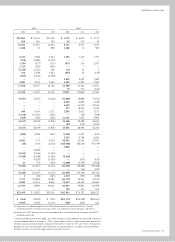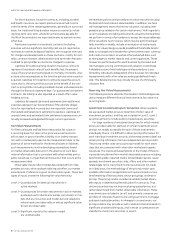GE 2012 Annual Report Download - page 82
Download and view the complete annual report
Please find page 82 of the 2012 GE annual report below. You can navigate through the pages in the report by either clicking on the pages listed below, or by using the keyword search tool below to find specific information within the annual report.80 GE 2012 ANNUAL REPORT
notes to consolidated financial statements
statistical analyses considering historical and projected default
rates and loss severity and aging, as well as our view on current
market and economic conditions. It is prepared by each respective
line of business. For Real Estate, this includes assessing the prob-
ability of default and the loss given default based on loss history of
our portfolio for loans with similar loan metrics and attributes.
We consider multiple factors in evaluating the adequacy of
our allowance for losses on Real Estate financing receivables,
including loan-to-value ratios, collateral values at the individual
loan level, debt service coverage ratios, delinquency status, and
economic factors including interest rate and real estate market
forecasts. In addition to evaluating these factors, we deem a Real
Estate loan to be impaired if its projected loan-to-value ratio at
maturity is in excess of 100%, even if the loan is currently pay-
ing in accordance with its contractual terms. Substantially all of
the loans in the Real Estate portfolio are considered collateral
dependent and are measured for impairment based on the fair
value of collateral. If foreclosure is deemed probable or if repay-
ment is dependent solely on the sale of collateral, we also include
estimated selling costs in our reserve. Collateral values for our
Real Estate loans are determined based upon internal cash flow
estimates discounted at an appropriate rate and corroborated
by external appraisals, as appropriate. Collateral valuations are
routinely monitored and updated annually, or more frequently for
changes in collateral, market and economic conditions. Further
discussion on determination of fair value is in the Fair Value
Measurements section below.
Experience is not available for new products; therefore, while
we are developing that experience, we set loss allowances based
on our experience with the most closely analogous products in
our portfolio.
Our loss mitigation strategy intends to minimize economic
loss and, at times, can result in rate reductions, principal forgive-
ness, extensions, forbearance or other actions, which may cause
the related loan to be classified as a TDR.
We utilize certain loan modification programs for borrowers
experiencing temporary financial difficulties in our Consumer
loan portfolio. These loan modification programs are primarily
concentrated in our non-U.S. residential mortgage and non-U.S.
installment and revolving portfolios and include short-term (three
months or less) interest rate reductions and payment deferrals,
which were not part of the terms of the original contract. We
sold our U.S. residential mortgage business in 2007 and as such,
do not participate in the U.S. government-sponsored mortgage
modification programs.
Our allowance for losses on financing receivables on these
modified consumer loans is determined based upon a formulaic
approach that estimates the probable losses inherent in the port-
folio based upon statistical analyses of the portfolio. Data related
to redefault experience is also considered in our overall reserve
adequacy review. Once the loan has been modified, it returns to
current status (re-aged) only after receipt of at least three consec-
utive minimum monthly payments or the equivalent cumulative
amount, subject to a re-aging limitation of once a year, or twice
in a five-year period in accordance with the Federal Financial
Institutions Examination Council guidelines on Uniform Retail
Credit Classification and Account Management policy issued in
June 2000. We believe that the allowance for losses would not be
materially different had we not re-aged these accounts.
For commercial loans, we evaluate changes in terms and
conditions to determine whether those changes meet the
criteria for classification as a TDR on a loan-by-loan basis. In
Commercial Lending and Leasing (CLL), these changes primarily
include: changes to covenants, short-term payment deferrals and
maturity extensions. For these changes, we receive economic
consideration, including additional fees and/or increased inter-
est rates, and evaluate them under our normal underwriting
standards and criteria. Changes to Real Estate’s loans primar-
ily include maturity extensions, principal payment acceleration,
changes to collateral terms, and cash sweeps, which are in
addition to, or sometimes in lieu of, fees and rate increases. The
determination of whether these changes to the terms and con-
ditions of our commercial loans meet the TDR criteria includes
our consideration of all of the relevant facts and circumstances.
When the borrower is experiencing financial difficulty, we care-
fully evaluate these changes to determine whether they meet
the form of a concession. In these circumstances, if the change is
deemed to be a concession, we classify the loan as a TDR.
When we repossess collateral in satisfaction of a loan, we
write down the receivable against the allowance for losses.
Repossessed collateral is included in the caption “All other assets”
in the Statement of Financial Position and carried at the lower of
cost or estimated fair value less costs to sell.
For Consumer loans, we write off unsecured closed-end
installment loans when they are 120 days contractually past due
and unsecured open-ended revolving loans at 180 days con-
tractually past due. We write down consumer loans secured by
collateral other than residential real estate when such loans are
120 days past due. Consumer loans secured by residential real
estate (both revolving and closed-end loans) are written down to
the fair value of collateral, less costs to sell, no later than when
they become 360 days past due. Unsecured consumer loans in
bankruptcy are written off within 60 days of notification of filing
by the bankruptcy court or within contractual write-off periods,
whichever occurs earlier.
Write-offs on larger balance impaired commercial loans
are based on amounts deemed uncollectible and are reviewed
quarterly. Write-offs are determined based on the consideration
of many factors, such as expectations of the workout plan or
restructuring of the loan, valuation of the collateral and the pri-
oritization of our claim in bankruptcy. Write-offs are recognized
against the allowance for losses at the earlier of transaction con-
firmation (e.g., discounted pay-off, restructuring, foreclosure, etc.)
or not later than 360 days after initial recognition of a specific
reserve for a collateral dependent loan. If foreclosure is probable,
the write-off is determined based on the fair value of the collat-
eral less costs to sell. Smaller-balance, homogeneous commercial
loans are written off at the earlier of when deemed uncollectible
or at 180 days past due.
























